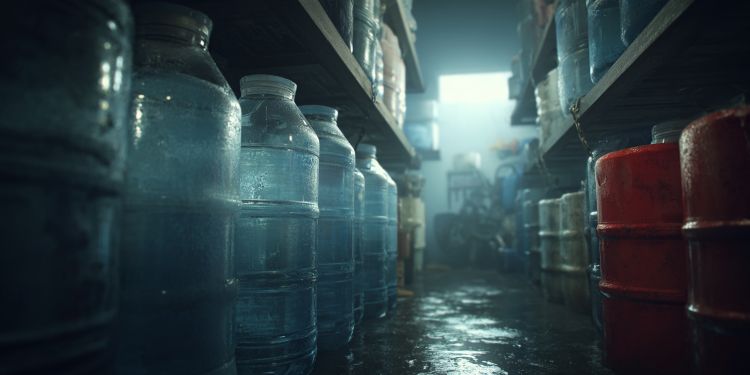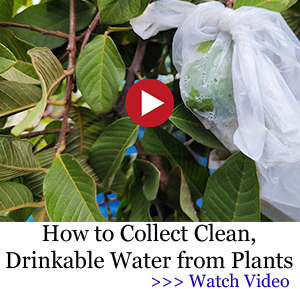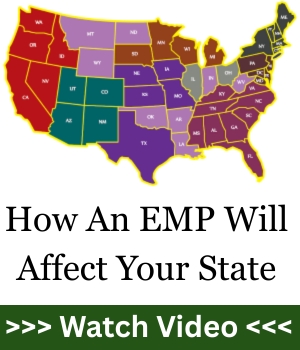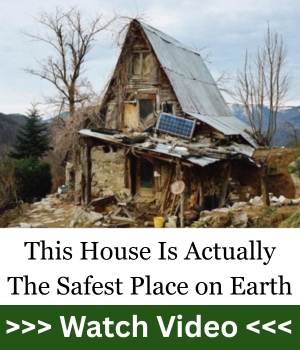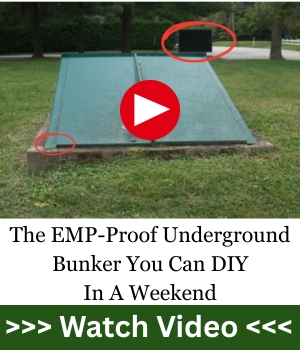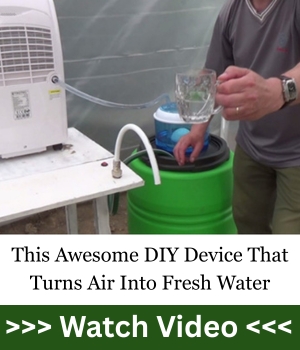If you want a quick answer, here it is: no, water does not expire. But if you think that means your emergency stash is always safe to drink, you are one bad blackout away from learning the hard way. Water is eternal. Containers are not. The moment you bottle it, seal it, store it or forget it in the back of your garage for three years, you introduce every weakness humans have ever invented.
What most people miss is that water storage is not a “set it and forget it” chore. It is a living system. Temperature, light, container quality and storage environment all work together to either protect or destroy your supply. These factors decide whether you drink clean water during a crisis or end up sick, dehydrated or desperate for a source you should never rely on.
The real danger is that water problems are invisible. You cannot always see bacteria. You cannot always smell chemical leaching. You will not know something is wrong until you drink it. By that point, the grid is already down, medical care is limited and the consequences hit hard. That is why this entire topic matters more than most preppers realize.
Why Pure Water Never “Expires”
Chemically speaking, water is just H2O. It does not go bad. It does not spoil. It does not suddenly turn toxic at midnight on the expiration date. The laws of nature do not care about marketing labels. The purity of water has remained unchanged for millions of years, long before we stamped expiration dates on plastic.
The expiration dates you see on bottles exist to protect companies, not consumers. They are legal shields. They mark when the packaging is most likely to begin degrading. But people see the date and assume the water is what expires, which leads to confusion and wasted supplies. Pure water itself is timeless. What changes is everything around it.
Related: Why You Should Never Drink Tap Water Again
Still, the fact that water is chemically stable does not make it immune to contamination. Once it enters a container, it interacts with whatever material holds it. Once it sits in your home, it is exposed to the environment, temperature, microbes and storage quality. Water lasts forever. Human handling is what puts expiration on the table.
When Water Actually Becomes Dangerous
There are only a handful of reasons your stored water becomes unsafe, and every single one of them becomes a real threat in a grid-down event. Contamination does not care about your prepping plan. It happens silently, slowly and without obvious warning signs. What looks clean might not be safe.
1. Chemical Leaching
Cheap plastic is enemy number one. Heat and time make plastic release microplastics and chemicals into the water. Perfect if you want to grow a third arm. Terrible if you want survival-grade hydration. Leaching increases in hot garages, vehicles, attics and sheds, which are exactly where most people store water.
Over years, even food-grade plastics can weaken. A small crack, a softened wall or a temperature spike is enough to introduce compounds you do not want in your bloodstream. In survival mode, the last thing you need is chemical exposure slowing your body down when you rely on every ounce of strength.
2. Bacterial Contamination
If the container is not sterilized, sealed properly or kept clean, bacteria will move in like squatters in an abandoned house. The longer it sits, the more the colony grows. This gets worse in warm storage areas where bacteria multiply faster.
Contaminated water is not “just a stomach ache.” It can take you out when medical help is unavailable. During emergencies, dehydration hits harder, immune responses slow and sickness spreads quickly. One bad container of water can derail an entire survival plan.
3. Algae Growth
Clear plastic plus sunlight equals algae. You may think “it is just green stuff.” But during SHTF there is no doctor waiting to bail you out. Algae signals exposure to light and microbial activity, neither of which belong in stored water.
The problem is that algae is a symptom, not the cause. If light is reaching your containers, so is heat. Both accelerate structural breakdown, microbial growth and reduced water quality. Algae is a warning sign that your setup is flawed.
4. Taste Degradation
This will not kill you, but try drinking stale plastic-flavored water when the power has been out for a week and morale is already low. Taste matters more during crises than people admit. Good tasting water keeps you hydrated. Bad tasting water gets avoided and ignored until dehydration hits.
Once taste shifts, it tells you something in the container changed. Chemical breakdown, oxygen exchange or subtle contamination can all alter the flavor. Do not ignore taste. It is a survival signal.
How Long Store-Bought Water Actually Lasts
Here is the Prepper answer: indefinitely if stored correctly, but realistically about 2 years before quality drops. Not because it becomes unsafe, but because the container weakens over time. Bottled water is convenient but not built for long-term storage.
Rotation is the secret weapon. If you cycle your supply yearly, you eliminate almost all storage risks. Keeping a fresh set of bottles prevents chemical degradation and keeps your emergency supply dependable. It is simple, cheap and effective.
Related: These 10 States Have the Worst Tap Water. Do You Live in One of Them?
The key is this: store-bought water is supplement storage, not your entire system. It is a backup, not a foundation. When disasters hit, you need solutions that last a decade, not a year.
The Smart Way to Store Water Long Term
If you want water that stays drinkable through blackouts, storms, EMP events or supply chain failures, follow these rules:
1. Use Food Grade Containers
Thick plastic or stainless steel are your best friends. No flimsy soda bottles. No containers that once stored chemicals. Ever. Containers that once held juice or milk are especially dangerous because sugars and proteins fuel bacterial growth.
Good containers are investments. They last for years, stay structurally sound and protect your water from contamination. Cheap containers create expensive problems. Spend wisely and store safely.
2. Keep It Cool and Dark
Heat speeds up chemical breakdown. Sunlight triggers algae. Find a cool closet, basement or interior room. Avoid garages unless temperature controlled. The environment you choose decides whether your water lasts months or decades.
Light exposure is one of the fastest ways to degrade water storage. Even small doses add up. Darkness protects your supply more than most people realize. Treat water like food. Give it a safe, stable home.
3. Seal It Air Tight
Oxygen, dust and bacteria are always waiting for the smallest gap. One loose cap is all it takes for your container to fail. Never trust old lids or worn threads. Replace damaged components immediately.
Air exchange invites contamination. Even if the water is pure when stored, airborne microbes can enter through microscopic openings. This is how “mysteriously spoiled” water happens. Seal your containers like your life depends on it.
4. Rotate Your Supply
Six months for tap water. One to two years for bottled water. Make rotation automatic. Schedule it. Label containers with fill dates. Build water rotation into your prepping calendar so it never gets neglected.
Rotating your supply does more than maintain freshness. It forces you to review your setup, check containers for stress or leaks and ensure nothing was accidentally exposed to heat. It is preventive maintenance for survival.
5. Purify Before Storing
If it comes from the tap, treat with unscented bleach or boil first. Do not trust your local system to be clean forever. Municipal systems fail. Filters fail. Old pipes shed debris. Start with clean water to end with clean water.
Purification at the beginning removes almost every long-term threat. When you control the input, you control the safety. Do not gamble on tap water. Prep it.
The One Thing People Forget
During a crisis, water is not just for drinking. You need it for cooking, washing, cleaning wounds and keeping morale stable. If you think 1 gallon per person per day is enough, you are already behind. Real survival planning requires at least 3 to 5 gallons per person per day.
When the grid goes down, water consumption skyrockets. Hygiene becomes a challenge. Water used for cooking cannot always be reused. Sanitation breaks down. People underestimate how fast they run through their supply until the first emergency hits.
Prepping for drinking alone is the biggest mistake beginners make. Water is life support for your entire system. Plan like your future self will thank you or curse you.
Build Real Independence With No Grid Projects
If water safety stresses you out now, imagine how it feels when the power stays off for two weeks straight. You need off-grid techniques you can depend on with zero electricity, zero outside help and zero guessing. That is where No Grid Projects becomes a game changer.
This guide shows you how to build real self-reliance without expensive tools, complicated systems or constant maintenance. It gives you practical solutions you can set up in a weekend, not theoretical tricks that require a workshop full of gear.
If you want to stop relying on luck and start relying on yourself, No Grid Projects is the next step.
How to Make Water Last Practically Forever
Water does not expire, but your system for storing it can fail without warning. The solution is redundancy. The more methods you have, the more secure your supply becomes. Rely on one system and you accept one point of failure.
Gravity filters, stored jugs, rain catchment, purification tablets, boiling setups, and backup tanks all work together to form a survival-grade water plan. Each layer covers a weakness in the others. This is how professionals prep.
You never want to be the person who realizes your entire water setup was flawed when the storm is already overhead.
Turn Your Property Into a Self-Reliant Water Fortress
If you want the exact systems homesteaders use to outlast droughts, power outages and supply shortages, The Self-Sufficient Backyard is the blueprint. It covers rain collection, purification, off-grid water setups and every method you need to stay hydrated no matter what hits.
This book is not theory. It is real-world, field tested knowledge from people already living the lifestyle. You get the layouts, the methods, the maintenance plans and the backup solutions that keep a home running during complete grid failure.
If you want water independence, this is where you start.
Final Thoughts
Water does not expire. That is the truth. But that does not mean it will keep you alive if you store it wrong. The moment the grid fails, the quality of your water becomes the difference between staying steady and falling apart. Water mistakes are silent but brutal.
The people who survive are the ones who think ahead. They prepare for human error, environmental threats, contamination risks and unforeseen chaos. They do not guess. They build systems that last. Water security is not hard. It just requires commitment.
Prep now. Store smart. Protect your supply. The future belongs to those ready for every scenario.
You may also like:
Why Water Purification Tablets Will Matter More Than Ammo When SHTF
This Man Was Nearly Killed In Front Of His Home… For Water! (Video)

